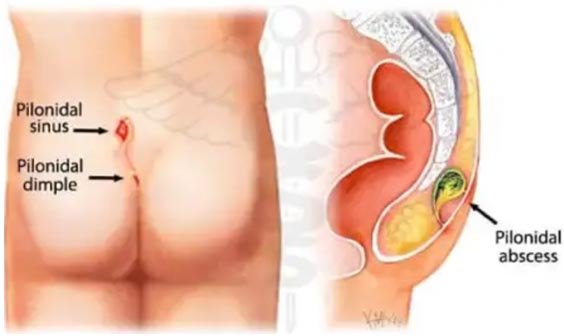Symptoms of Pilonidal Sinus)
- Reddened, sore skin around the area
- Pus or blood draining from the abscess, causing a foul odor
- Pain when sitting or standing
- Hair protruding from the lesion
- Formation of more than one sinus tract, or holes in the skin
Major Causes
The exact cause of this condition isn’t known, but its cause is believed to be a combination of changing hormones, hair growth, and friction from clothes or from spending a long time sitting.
Diagnosis of Pilonidal Sinus
Pilonidal Sinus is diagnosed by an investigation of the symptoms and a physical exam by a proctologist.
Treatment for Pilonidal Sinus available at Santhosh Hospital
If your case is diagnosed early on, you aren’t experiencing severe pain, and there’s no sign of inflammation, it’s likely that your doctor will prescribe a broad-spectrum antibiotic. A broad-spectrum antibiotic is an antibiotic that treats a wide range of bacteria. It’s important to realize that this won’t heal the sinus tract, but it will give you relief from the infection and discomfort.
Lancing
This procedure alleviates symptoms from an abscess, or a collection of pus inside the sinus. Before this procedure, your doctor will give you a local anesthetic. The abscess is opened using a scalpel andany hair, blood, and pus from inside the abscess is cleaned away.
The wound is packed with sterile dressing and allow it to heal from the inside out. The wound usually heals within four weeks, and many people don’t require any further treatment.
Phenol Injection
For this type of treatment, your doctor will first give you a local anesthetic. They will then inject phenol, a chemical compound used as an antiseptic, into the cyst. This procedure may need to be repeated several times. Eventually, this treatment will cause the lesion to harden and close.
This treatment has a very high recurrence rate.
Laser Surgery
Our modality of treatment also includes laser surgery. Laser Surgery is recommended for recurring PNS or if you have more than one sinus tract. You will first be given a local anesthetic. Then, the surgeon will open the lesions, removing all of the pus and debris. Once this process is complete, the surgeon will stitch the wounds closed.



